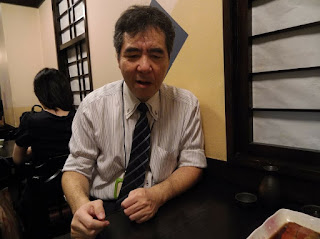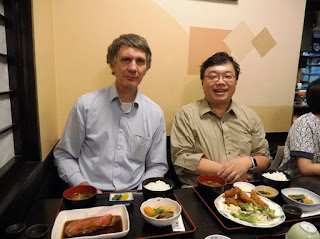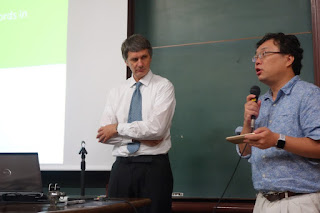We then traveled to Tokyo city, where I got a nice room in the University Hospital's Guest House, located on the Tokyo University campus, a very nice oasis in the middle of a busy city.
The afternoon was spend on a visit to UMIN itself, where I was very well received by Prof. Kiuchi, director of UMIN, and taken care of by the coworkers Ms. Karube and Ms. Watari. This was really necessary, as my voice was in not-too-good shape, as I catched a cold on my voyage to Oxford the week before. So they provided me with lots of hot drinks and sweeties that are good for the throat. Also Dr. Masafumi Okada was there, who did such marvelous things with the CDISC ODM standard, and surely is the number 1 expert on ODM in Japan.
On our way from the guest house to the UMIN offices, I also observed Japanese students playing American Football. This was a bit surprising for me - I presume this sport was introduced by American soldiers.
After diner in a nice local restaurant (popular with students),
Yoshiter Chiba, driving force of CDISC in Japan
With my colleague Dr. Masafumi Okada
Thursday morning was devoted to a meeting with Japanese specialists in the field of clinical research, with representatives of several universities, and of representatives of AMED, the Japanese Agency for Medical Research and Development, a rather young organization that is coordinating medical and clinical research in Japan. This is a very good thing, as one needs to realize that due to demographic evolution and a low birth rate, 40% of the population will be over 65 years old in 2050!
During this meeting, I gave a short presentation titled "Integration of Electronic Health Records in Clinical Research", depicting the work done at CDISC, EHR4CR in Europe and my personal perspective on the use of electronic health records in clinical research. This meeting brought me great insight in the Japanese situation, and provided me many useful contacts. I was especially impressed by the presentation and work of Prof. Matsumura, who has set up a large system for the Osaka region. You can find one of his publications here. Also the other presentations were very interesting, but I can't describe them all here.
In the afternoon, we had the "CDISC Symposium", attended by over 150 participants, in one of the larger lecture halls at the university. You can find the program here (in Japanese). If you would like to obtain a copy in English, just drop me a mail. This symposium (mostly in Japanese) covered several aspects of CDISC in Japan, and also included a presentation from a PMDA respresentative.
Prof. Kiuchi (Director of UMIN) giving the introductory presentation
Also Dr. Masafumi Okada and Yushiteru Chiba provided presentations.
Dr. Okada's presentation was titled "Metadata Mapping and eSource". You can find the English version of his slides here.
It was then my turn to present (but not in Japanese 😉), and obtained very nice introductory words from Dr. Okada:
I gave a presentation titled "The Use of Electronic Health Records in Clinical Research - The Value of CDISC Standards".
The slides will be posted on the UMIN website very soon. If you would like to receive a copy sooner, please again let me know. Also all the slides of the presentations of the colleagues will be will be available soon.
Later that evening we then had a "Japanese hot plate cooking" (teppanyaki) at a local restaurant with all the symposium speakers. It was great fun (and tasted very good), but I was glad we had several specialists in the group explaining how to handle the dishes.
The next morning, we traveled to Nagoya to attend a CJUG (CDISC Japanese User Group) meeting by Shinkansen train. This high speed train (we drove a type N700A, maximum speed 285 km/h) only took somewhat more than 1.5 hours for the about 356 km trajectory. Unbelievable! And this is even not the fastest model! There is also the E5 model, which makes it up to 320 km/h! The train connection between the 2 largest cities in Austria (Graz and Vienna, distance 200km) takes 2.5 hours. Yes, our own train system is really underdeveloped.
The meeting was held in the "board hall" of the Nagoya Medical Center hospital and was attended by about 50 CJUG members (so I also exchanged that number of business cards 😊). Here is an impression from the meeting room:
The meeting started with a webconference presentation on Lauren Becnel of CDISC about the SHARE API 2.0. This brought us a number of new insights, bringing some hope that we can finally come to a modern set of CDISC standards that can be used through RESTful web services.
My own presentation was titled "CDISC and Artificial Intelligence", explaining what needs to change and needs to be done to be able to use artificial intelligence in working with CDISC standards. One of the topics was about machine-readable (SDTM and other) standards documents and especially Implementation Guides, as well as considerable better controlled terminology (now essentially just lists without system nor relationships between terms).
I will probably publish the slides in the near future.
After my own presentation, my voice was finally ruined, so I was unfortunately not able to discuss a lot with my Japanese colleagues, many I knew from the CJUG mailing lists. But it was great that I could finally meet all these great people in person.
As part of the meeting, we also had a visit to the local clinical research center, bringing even more insight into how clinical research works in Japan. We saw a list of all the research projects that were executed, some with very modern EDC systems, but also found projects with MS Excel as the "EDC system" even for larger clinical trials. With respect to that, Japan is not different from the rest of the world...
After the meeting part of the participants went to the city center by bus. I learned that in Nagoya, you pay when you drop of the bus using the exact amount in coins. Most people however pay electronically, using Felica (RFID) technology. Close to the train station (and our hotel for that night), we had a last very nice diner, where I was almost the only person not taking a beer (due to my throat problems):
Yohiteru Chiba (on the right on the picture) took care that we didn't make it late, as we would need to leave at 06:20 the next morning. We then traveled to Nagoya airport, where we flew back to Tokyo Narita airport. Unfortunately the weather was pretty bad, so that we did not get a look on Mount Fuji. At Tokyo airport, I then needed to say "goodbye" to Yoshiteru, who took so well care of me all these days. A big "thank you" to him, his colleagues at UMIN, and all these wonderful people who I met in Japan.
My journey was not come to an end yet. Taken from Nagoya, it took almost 24 hours before reaching Vienna (again over London Heathrow). In the next days, my voice only recovered slowly - it took several days before I could do presentations again.
This trip has been an unforgettable experience for me. Although I was in Japan for only a few days, I learned to appreciate the Japanese people and culture, and especially experienced the very high level in which CDISC standards are implemented, this altough the language barrier. This language barrier was also not-so-easy to overcome for me, and there is a large number of discussions I will need to follow up by E-mail. I will however do this with great pleasure.
Acknowlegments: Thank you to Dr. Masafumi Okada for providing the photographs. These are and remain under Dr. Okada's copyright.










No comments:
Post a Comment